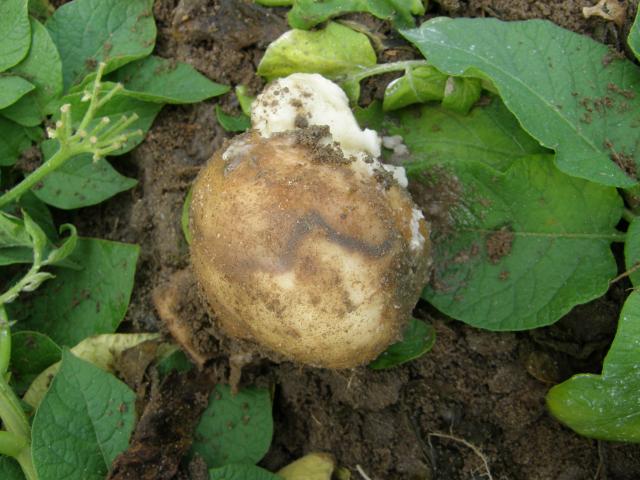Continued response to major biosecurity incidents
The Department of Primary Industries and Regional Development is continuing to dedicate efforts to two biosecurity incidents – the Tomato potato psyllid (TPP) pest and Dickeya dianthicola bacterium – which are having significant impacts on industry.
Tomato potato psyllid
First discovered in Western Australia in February this year, TPP is a plant pest which feeds on tomato, potato, capsicum, chilli, goji berry, tamarillo, eggplant and sweet potato, leading to a loss of plant vigour and yield.
TPP can also carry a bacterium called Candidatus Liberibacter solanaceum (CLso) which is associated with the ‘zebra chip’ potato disease.
Agreement has been reached by federal and state governments and the horticulture industry on a national plan to manage and limit the impact of the TPP/CLso complex.
The transition to management plan continues through to mid-May 2018, and is led by the department with support from affected industries, and federal and state governments.
Surveillance will target areas where there are known populations of TPP during Spring 2017 through to Autumn 2018, when insect activity is expected to be at its peak.
The aim of surveillance is to reach a high level of confidence regarding the presence or absence of CLso.
The TPP transition to management team will provide further details to commercial growers and home gardeners about how they can assist trapping psyllids.
The department will also lead research work including examining chemical control options, post-harvest disinfestation trials, and assessing biological control options using predator species.
Working closely with TPP-affected industries in WA, the department will develop enterprise management plans to help minimise the spread and impact of the pest on-farm through to post farm gate.
Following the National Management Group’s decision in April that it is not technically feasible to eradicate the pest in Western Australia, department staff have continued to work with local and national industry bodies, and other jurisdictions, to facilitate interstate trade.
Dickeya dianthicola
In June, the Dickeya dianthicola bacterium was detected in Australia for the first time on a Western Australian potato growing property.
The bacterium has a wide host range and can also affect other horticultural crops including some ornamental flowers (such as dahlia, freesias and carnations), globe artichoke and chicory.
Dickeya dianthicola can lead to significant yield loss.
Disease symptoms in potatoes include blackleg, aerial stem rot and tuber soft rot.
Slimy, wet black stems is a characteristic symptom. In ornamental crops, symptoms include wilting and poor plant growth.
Although in some instances plants and tubers may not show any signs of infection.
The discovery of Dickeya dianthicola triggered a national incident response led by the department, which has since conducted extensive surveillance, sampling and testing to determine the extent of the outbreak, and to also determine the pathway through which the bacteria entered WA.
Investigations have led to the discovery that infected dormant dahlia tubers grown on a potato growing property are the likely source of infection.
These dahlia tubers originated from the eastern states, and in WA were grown prior to the planting of a potato crop in the same plot.
Other states have commenced surveillance and testing of both potato and dahlia crops for Dickeya dianthicola.
In Western Australia the bacterium has been confirmed on four commercial potato growing properties in two potato varieties.
It was detected in potatoes on three of these properties, which have been quarantined.
Throughout the incident the department has made every effort to work closely with quarantined growers to determine how they can continue their business operations without risking spread of the disease to other properties.
This has included allowing potatoes to be sold as ware under strict biosecurity protocols.
The department will continue to assist growers by developing other management options.
This includes assessing how the Certification Potato Seed Scheme and Registration Rules can be modified to manage Dickeya dianthicola.
The department has also asked industry to consider and endorse a proposed strategy for the disease including the lifting of quarantine restrictions.
Growers would then be responsible for managing the disease to minimise future impacts on the industry.
If quarantine is lifted, potatoes from infected properties may be sold as seed, with buyers being responsible for managing the risk involved.
Additional information
The emergence and distribution of both TPP and Dickeya dianthicola highlights the need for growers to follow good farm biosecurity procedures to prevent the entry, establishment and spread of production pests.
DPIRD has developed a number of information sheets to assist growers implement biosecurity measures. They are available from the web pages below:
TPP – www.agric.wa.gov.au/TPP
For more information contact Rohan Prince, Director, Irrigated Agriculture, South Perth on +61 (0)8 9368 3210.
Dickeya dianthicola – www.agric.wa.gov.au/ddianthicola
For more information contact Bill Trend, PDD Incident Controller, South Perth on +61 (0)8 9368 3535.

